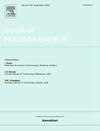掺杂稀土化合物的硼酸盐玻璃在中子辐照过程中的性能:快中子质量去除截面和二次伽马射线发射分析
IF 2.3
3区 工程技术
Q1 NUCLEAR SCIENCE & TECHNOLOGY
引用次数: 0
摘要
采用熔体淬火法制备了三种掺少量稀土氧化物(La2O3、Eu2O3和Dy2O3)的硼酸锌玻璃。制作玻璃样品的目的是研究稀土元素对中子辐照后二次伽马射线发射的影响。为了达到预期的目的,将制备好的玻璃样品放置在胶囊中,胶囊悬浮在ivv - 2m核反应堆的干燥通道中,制备好的样品以8.11E + 11 n/(cm2.s)的快中子通量和8156E + 12 n/(cm2.s)的热中子通量照射4小时。La2O3、Eu2O3和Dy2O3掺杂玻璃的吸收剂量分别为7.41E + 04、3.06E + 04和5.44E + 04 Gy。辐照过程结束后,立即使用配备Genie-2000软件的堪培拉伽玛光谱仪的HPGe探测器进行二次伽玛发射分析。分析结果表明,La2O3掺杂后总活度最高,达到14.45 MBq, Eu2O3掺杂后总活度最低,达到6.26 MBq。此外,在辐照玻璃样品周围的不同距离上估计了辐照玻璃样品的剂量率。此外,还估计了辐照玻璃样品在不同时期的剂量率。本文章由计算机程序翻译,如有差异,请以英文原文为准。
Performance of the borate glasses doped with some rare earth compounds during the neutron irradiation: Analysis for the mass removal cross section of fast neutrons and secondary gamma-ray emission
Three zinc borate glasses doped with a small concentration of various rare earth oxides (La2O3, Eu2O3, and Dy2O3) were fabricated using the melt quenching method. The fabrication of glass samples aims to investigate the impact of rare earth elements on the secondary gamma-ray emission following neutron flux irradiation. To achieve the desired goal, the prepared glass samples were placed in a capsule, which is suspended within a dry channel of the nuclear reactor IVV-2 M. The prepared samples were irradiated with fast neutron flux of 8.11E + 11 n/(cm2.s) and a thermal neutron flux of 8156E + 12 n/(cm2.s) for four hours. The absorbed doses by the prepared glass samples reach 7.41E + 04, 3.06E + 04, and 5.44E + 04 Gy for glasses doped with La2O3, Eu2O3, and Dy2O3, respectively. Immediately after the irradiation process ended, analysis for the secondary gamma-emission was performed using a HPGe detector from the CANBERRA gamma spectrometer equipped with Genie-2000 software. The analysis shows that the highest total activity reaches 14.45 MBq, which is released from glasses-doped La2O3, while the lowest activity reaches 6.26 MBq, released from glasses-doped Eu2O3. Additionally, the dose rate from the irradiated glass samples was estimated at various distances surrounding the irradiated samples. Also, the dose rate across various periods of time was estimated for the irradiated glass samples.
求助全文
通过发布文献求助,成功后即可免费获取论文全文。
去求助
来源期刊

Annals of Nuclear Energy
工程技术-核科学技术
CiteScore
4.30
自引率
21.10%
发文量
632
审稿时长
7.3 months
期刊介绍:
Annals of Nuclear Energy provides an international medium for the communication of original research, ideas and developments in all areas of the field of nuclear energy science and technology. Its scope embraces nuclear fuel reserves, fuel cycles and cost, materials, processing, system and component technology (fission only), design and optimization, direct conversion of nuclear energy sources, environmental control, reactor physics, heat transfer and fluid dynamics, structural analysis, fuel management, future developments, nuclear fuel and safety, nuclear aerosol, neutron physics, computer technology (both software and hardware), risk assessment, radioactive waste disposal and reactor thermal hydraulics. Papers submitted to Annals need to demonstrate a clear link to nuclear power generation/nuclear engineering. Papers which deal with pure nuclear physics, pure health physics, imaging, or attenuation and shielding properties of concretes and various geological materials are not within the scope of the journal. Also, papers that deal with policy or economics are not within the scope of the journal.
 求助内容:
求助内容: 应助结果提醒方式:
应助结果提醒方式:


